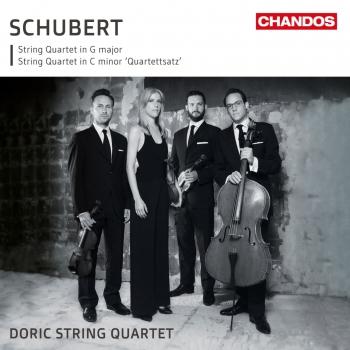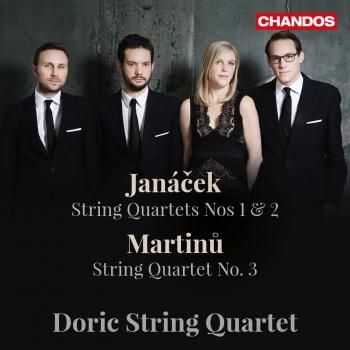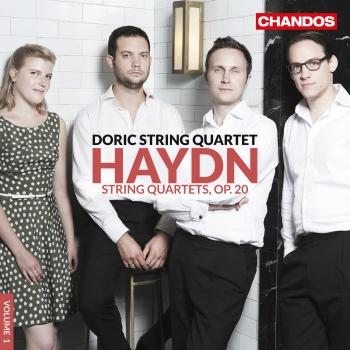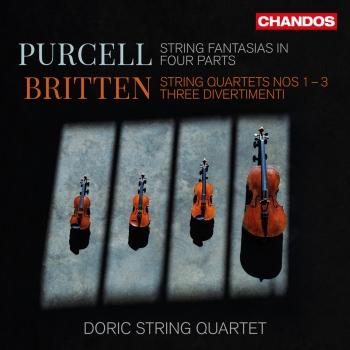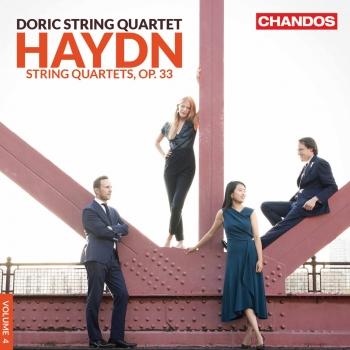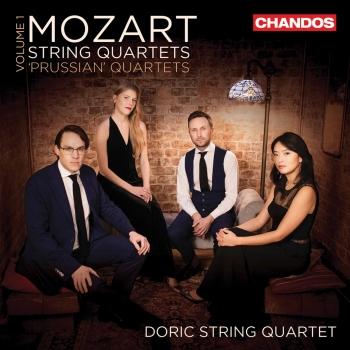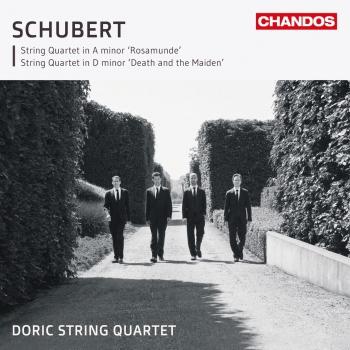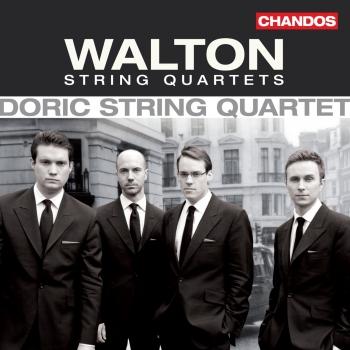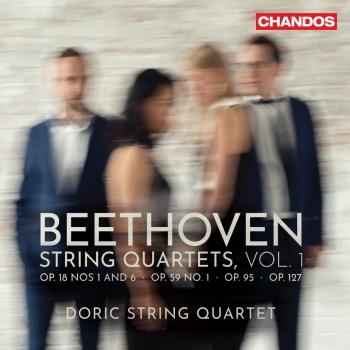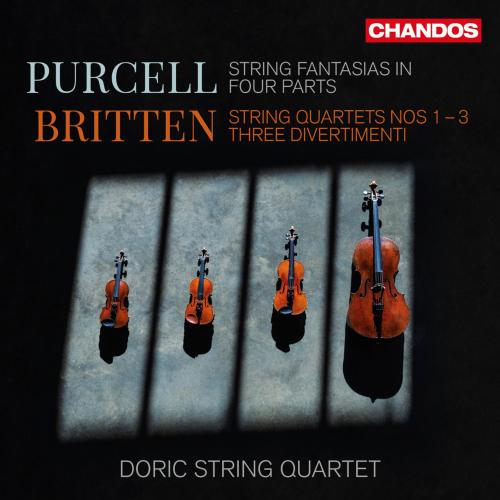
Britten & Purcell: Chamber Works for Strings Doric String Quartet
Album Info
Album Veröffentlichung:
2019
HRA-Veröffentlichung:
29.03.2019
Label: Chandos
Genre: Classical
Subgenre: Chamber Music
Interpret: Doric String Quartet
Komponist: Henry Purcell (1659-1695), Benjamin Britten (1913-1976)
Das Album enthält Albumcover Booklet (PDF)
- Benjamin Britten (1913 - 1976): String Quartet No. 1, Op. 25:
- 1 String Quartet No. 1, Op. 25: I. Andante sostenuto 09:05
- 2 String Quartet No. 1, Op. 25: II. Allegretto con slancio 02:55
- 3 String Quartet No. 1, Op. 25: III. Andante calmo 10:28
- 4 String Quartet No. 1, Op. 25: IV. Molto vivace 03:40
- 3 Divertimenti:
- 5 3 Divertimenti: I. March. Allegro maestoso 03:36
- 6 3 Divertimenti: II. Waltz. Allegretto 02:58
- 7 3 Divertimenti: III. Burlesque 03:18
- String Quartet No. 3, Op. 94:
- 8 String Quartet No. 3, Op. 94: I. Duets. With Moderate Movement 05:38
- 9 String Quartet No. 3, Op. 94: II. Ostinato. Very Fast 03:11
- 10 String Quartet No. 3, Op. 94: III. Solo. Very Calm 06:01
- 11 String Quartet No. 3, Op. 94: IV. Burlesque. Fast, con fuoco 02:16
- 12 String Quartet No. 3, Op. 94: V. Recitative & Passacaglia (La serenissima) 10:01
- Henry Purcell (1659 - 1695): Fantasy in F Major:
- 13 Fantasy in F Major, Z. 737 03:27
- 14 Fantasy in C Minor, Z. 738 03:29
- 15 Fantasy in D Minor, Z. 739 03:41
- 16 Fantasy in A Minor, Z. 740 02:55
- 17 Fantasy in E Minor, Z. 741 03:27
- Benjamin Britten: String Quartet No. 2, Op. 36:
- 18 String Quartet No. 2, Op. 36: I. Allegro calmo senza rigore 08:13
- 19 String Quartet No. 2, Op. 36: II. Vivace 03:23
- 20 String Quartet No. 2, Op. 36: III. Chacony. Sostenuto 18:56
Info zu Britten & Purcell: Chamber Works for Strings
Founded in 1998 at Pro Corda, Suffolk, the multi-award-winning Doric String Quartet describes recording Britten’s quartets as a significant milestone: ‘In our recording we have endeavoured to tread a line that brings out the humanity in these works but also recognises the need for distance and fragility. This is very personal and intimate music, yet also world-encompassing and timeless.’ The Quartet continues: ‘Another feature of this recording is that Hélène Clément, our violist, is playing on Benjamin Britten’s own viola. This instrument (on loan from the Britten-Pears Foundation) was made in 1843 in Milan by Francesco Guissani. It was previously owned by the composer Frank Bridge who gave it to Britten, as a departure gift when Britten and Pears set sail for the USA in 1939.’ Hélène Clément writes: ‘To be able to explore the music of Britten with the very sound that the composer had in his ears is the greatest honour and joy I could have imagined.’
Britten and Purcell: Benjamin Britten (1913 – 1976) declared that one of his principal aims in composing his opera Peter Grimes (1945) had been his desire ‘to try to restore to the musical setting of the English language a brilliance, freedom and vitality’ which he felt had been ‘curiously rare since Purcell’. His growing passion for the music of Henry Purcell (1659 – 1695) at this time was part of a more general revival of interest in, and awareness of, the achievements of the English baroque composer, which was spearheaded by two musicologists and conductors: Jack Westrup in Oxford, and Anthony Lewis in Birmingham and at the BBC. Composers and performers were also vital contributors to this Purcell renaissance, notably Michael Tippett, who conducted performances of Purcell at Morley College in London during the 1940s, and the countertenor Alfred Deller, for whom Britten wrote Purcellian vocal lines in his opera A Midsummer Night’s Dream (1960).
As was the case with Tippett, who realised songs by Purcell for modern performance and whose own compositional style was influenced by his example, the involvement of Britten with Purcell was reflected in both editorial and original projects. Britten began preparing realisations for voice and piano of Purcell’s songs in 1939, and his output of such arrangements – stimulated by the 250th anniversary of Purcell’s death – peaked in 1945, during which year he realised no fewer than fourteen songs, as well as paying creative homage to the composer in his String Quartet No. 2. He then took a theme from Purcell’s Abdelazar (1695) as the basis for his enduringly popular orchestral work The Young Person’s Guide to the Orchestra (1946). More song realisations would follow, including items from the collections Harmonia Sacra and Orpheus Britannicus, prepared in collaboration with his partner, the tenor Peter Pears. Britten also made an arrangement of Purcell’s Chacony in G minor (1948), which he liked to conduct on his concert tours: unashamedly dramatic in its vitality and dynamic contrasts, his arrangement is a vivid illustration of the excitement which the rediscovery of Purcell’s music generated....
Doric String Quartet
The Doric String Quartet is now firmly established as one of the outstanding quartets of their generation. In 2008 they won 1st prize in the Osaka International Chamber Music Competition in Japan, 2nd prize at the Premio Paolo Borciani International String Quartet Competition in Italy, where they also received a special mention for their performance of Haydn, and the Ensemble Prize at the Festspiele Mecklenburg-Vorpommern in Germany.
Now in its 12th season highlights over the last year have included a critically acclaimed Haydn evening at Wigmore Hall broadcast by BBC Radio 3, debut recitals in Paris (Auditorium du Louvre), Milan and Frankfurt, and visits to the Schwetzinger, Florestan, Isle of Man and East Neuk Festivals. Further afield the Quartet toured throughout Japan and returned to Israel and South East Asia. They have collaborated with Mark Padmore, Chen Halevi, Julius Drake, Piers Lane, Melvyn Tan, the Leopold String Trio and Florestan Trio.
During 2009/10 the Quartet return to Wigmore Hall four times, as Quartet and in recitals with Philip Langridge, Andrew Kennedy (for a world premiere) and Alasdair Beatson. Future engagements include recitals at the Konzerthaus in Berlin and in Lucerne, Brussels and Hamburg, return visits to Israel and Italy, and debut concerts in Australia, New Zealand, Spain, and the USA.
In November the Doric’s first commercial CD is released on the Wigmore Hall Live label of their Haydn concert at Wigmore Hall on 15 January 2009 and in 2010 they record their first CD for Chandos as part of a long-term collaboration.
Formed in 1998 at Pro Corda, The National School for Young Chamber Music Players, in Suffolk, from 2002 the Doric String Quartet studied on the Paris-based ProQuartet Professional Training Program, where they worked with members of the Alban Berg, Artemis, Hagen and LaSalle Quartets and with Gyorgy Kurtag. The Quartet continue to work with Rainer Schmidt (Hagen Quartet) at the Music Academy in Basel.
In 2000 the Doric String Quartet won the inaugural Bristol Millennium Chamber Music Competition which led to a seven year residency at the Wiltshire Music Centre combining a concerts series with education work across the region. They continue this relationship as ‘Artists in Association’. The Quartet went on to give recitals at the Purcell Room and Wigmore Hall under the auspices of the Park Lane Group, appeared at the ORF (Austrian Radio) Funkhaus in Vienna in 2003 and made their Edinburgh Festival debut in 2006.
Alex Redington and Jonathan Stone completed their postgraduate studies at the Royal Academy of Music in 2005 where they studied with Howard Davis. Simon Tandree studied in Saarbrücken and Detmold with Dietmut Poppen. John Myerscough graduated from Selwyn College, Cambridge in 2003 and is now a Fellow of the Guildhall School of Music and Drama where he studies with Louise Hopkins.
The Doric String Quartet acknowledges the generous support of an Anonymous Foundation.
Booklet für Britten & Purcell: Chamber Works for Strings









